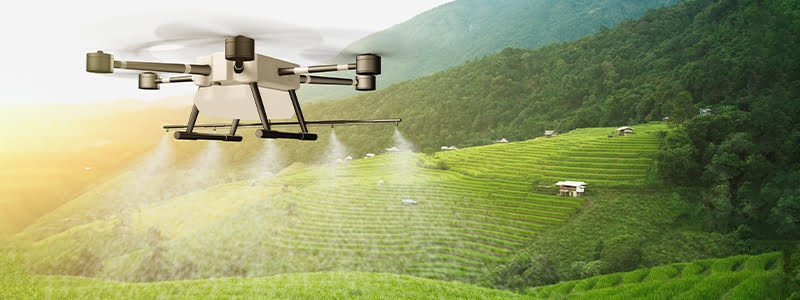AgTech refers to the use of technology in agriculture, and the R&D Tax Incentive is cultivating a culture of technological advancement in what has historically been one of the most vital sectors in Australia’s economy.
The government provides an R&D Tax Incentive for AgTech. Now agriculture has come a long way since the days of simple tools and technologies such as the scythe, hoe, and horse-drawn plough, when the incentives to increase productivity included things like carrots on sticks or the threat of the whip (normally used on the horses but perhaps also by rent collectors on unfortunate tenant farmers). But we still need to keep innovating. In the 21st century Australia, for the farmers at least, there are some visionary and generous incentives to stimulate innovation in the agriculture/farming sector, one of which is the Australian government’s Research and Development Tax Incentive (RDTI). Some of the technologies and applications that have emerged from R&D in Agtech — also referred to as Agritech, AgriTech, or Agrotech — and which are already in use, include the following:
- Agricultural drones
- Satellite photography and sensors
- IoT-based sensor networks
- Weather forecasting
- Automated irrigation
- Light and heat control
- Intelligent software analysis for pest and disease prediction and soil management.
Australia exports around 70% of its total value of agriculture, fisheries and forestry production, which accounted for $50.1 billion in 2019/20. Given Australia’s high labour costs, the labour-saving technologies that are synonymous with AgTech will be increasingly featured in a wide range of agricultural activities, and the RDTI will be a key driver of these developments.
What expenditure can my company claim as part of the Agtech R&D we do?
Expenditure associated with Core and Supporting R&D activities can be claimed as part of the RDTI. Core R&D activities are defined in the legislation as experimental activities, whose outcome can only be determined by applying a systematic progression of work that proceeds from a hypothesis/hypotheses to experiment, observations and evaluations, and leads to logical conclusions. The purpose of the R&D must be to generate new knowledge.
With this in mind, for the specific case of R&D in Agtech, some examples of things that may be claimed as contributing to Core or Supporting R&D activities include:
- Design, development and testing of experimental prototypes (e.g. drones, robotics, machinery, sensors, etc.) that will be used in the experimental AgTech activities
- Components / parts used in the production of experimental prototypes, or the decline in value of capital equipment used in eligible R&D activities
- Salaries/payments to staff or contractors who conduct the R&D
- A proportion of overheads (e.g., rent/leasing of facilities used to conduct the R&D, energy, and software licences used in experimental designs) incurred in the R&D activities.
What records or information should we keep of our R&D?
In scientific research, the “publish or perish” paradigm is well known, but for the RDTI we could perhaps modify this to “record or regret”. Although the RDTI legislation does not prescribe the types of supporting evidence that should be recorded or maintained by an RDTI claimant, it is clear that such evidence or records must be gathered. Valid records for the purpose of claiming the RDTI are any records that verify or contribute to calculating your claim; however, it is imperative that you have records detailing the ‘unknown outcomes’, ‘new knowledge’ sought, and hypothesis/hypotheses for the experimental activities.
All your photos, notes, written or oral observations recorded, and diary entries are important artefacts that serve as proof of what was done, and could easily be used as solid contemporaneous evidence in the case of an audit.
Something that is very important in showing that the outcomes of the experiments could not have been known beforehand is to keep state of the art and literature searches relating to your particular area of investigation, as well as other internal records that detail the specific uncertainties that could only have been resolved through an experimental progression of work.
Some industry examples of the RDTI cultivating a strong Agtech R&D culture
AgriDigital, which was founded in 2015, is now one of Australia’s leading AgTech startups. They developed the world’s first blockchain settlement system for the agricultural industry, which is being used to track bulk grain from paddock to point of sale anywhere, anytime. In one of their earlier years developing their novel technologies, the RDTI helped them receive almost half (43.5%) of their annual R&D budget back the following year. As their Executive Director and Co-founder Bob McKay noted, this liquidity helped them scale the business and accelerate their growth. With 7.45k active users, accounting for a total of 28.62 million metric tonnes of grain handled, and $4,233 million in transactions, this is a shining example of an AgTech and RDTI success story.
In 2012, from the back verandah of their Gindie farm in the Central Highlands of Queensland, Andrew and Jocie Bate began inventing, developing and streamlining farm robots for their new company, SwarmFarm Robotics. Since then they’ve spent more than $5 million developing their farm robot vision. Along the way they’ve had assistance in the form of research co-operation with several universities, industry partnerships with companies such as Bosch, Elders and Telstra, and grants from the federal and Queensland governments, but as Jocie herself emphasizes: “We wouldn’t have survived without the [federal] R&D tax incentives – they made all the difference”.
AOS is a software and robotics company specialising in autonomous and intelligent systems, and is a partner in a consortium for developing a novel autonomous mobile robot for weed control to maximise agricultural productivity. As part of the project, which is forecast to continue until 2023, the group received a Cooperative Research Centres Projects (CRC-P) grant of $2,850,000 — these grants support short-term collaborative research projects and are another source of funding that complements the R&D Tax Incentive for AgTech and other closely related industries.
Agtech companies benefit from the specialist expertise that Fullstack has in successfully navigating the RDTI. Contact us to ensure you obtain all the RDTI benefits you’re entitled to.
Was this article helpful?
Related Posts
- 5 Biggest Questions on Australia’s R&D Tax Incentive
Considering applying for the R&D Tax Incentive? We cover off on the 5 biggest questions…
- R&D Tax Incentive Updates for FY23 per the 2020-2021 Budget
What do recent budget proposals mean for the status of the R&D Tax Incentive in…
- R&D Tax Incentive 2020 Budget Updates
How does the 2020 Federal budget impact access to the R&D Tax Incentive? Read on…
- R&D Tax Incentive - Preparing for 30 June
Wanting to optimise your R&D Tax Incentive claim, whilst ticking all the boxes? Read on…

















